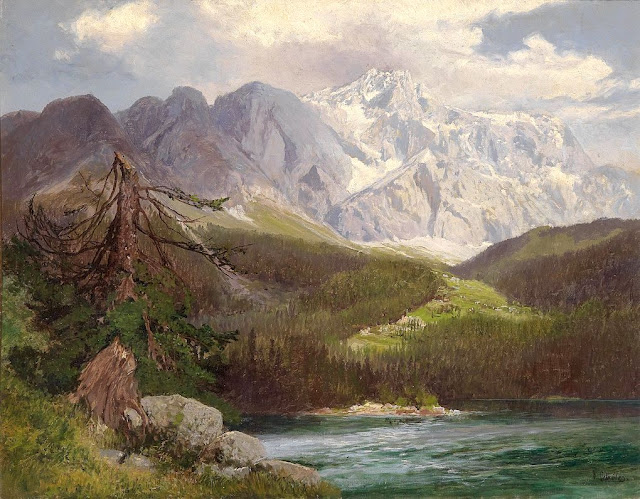ADALBERT STIFTER (1805-1868),
Le Watzmann (2,713m - 8,901ft)
Allemagne (Alpes bavaroises)
In Der Königsee mit dem Watzmann,1837, huile sur toile
La montagne
Le Watzmann (2,713m - 8,901ft)) est massif montagneux des Alpes bavaroises situé au sud de Berchtesgaden. C'est le troisième plus haut d'Allemagne et le plus élevé qui soit entièrement situé sur le territoire allemand. Il se compose de trois principaux sommets disposés sur un axe Nord-Sud : le Hocheck (2651 m), le Mittelspitze (2713 m) et le Südspitze ( 2712 m). Le massif de Watzmann comprend également cinq sommets inférieurs situés entre les sommets principaux : le Watzmannfrau (2307 m), le Watzmann Wife, également connu sous le nom de Kleiner Watzmann ou Petit Watzmann), et le Watzmannkinder (Les enfants Watzmann). Cet alignement sur modèle d'une famille comme une famille qui serait en rang.doit son origine à une légende selon laquelle le pays aurait été autrefois dominé par un cruel roi nommé Watzmann qui répandait avec sa femme et ses enfants la peur et l'effroi parmi les paysans. Alors que le roi rossait un paysan, la femme de celui-ci leur jeta un sort et aussitôt, la terre s'ouvrit, cracha du feu et transforma le roi et sa famille en pierres. La légende dit aussi que le Königssee et l'Obersee sont remplis du sang de la cruelle famille royale.
L'ensemble du massif est aujorud 'hui portégé à l'intérieur du Parc national de Berchtesgaden. Le glacier du Watzmann situé sous la célèbre face-est du Watzmann dans le cirque de Watzmann, est entouré par l'arête du Watzmanngrat, le Watzmannkindern et le Kleiner Watzmann. La première ascension du sommet central (Mittelspitze) a été réalisée en 1799 ou août 1800 selon les sources par le slovène Valentin Stanic. La première ascension des trois pointes (Hocheck, Mittelspitze, Südspitze) a été réalisée en 1868 par le guide de Ramsau am Dachstein Johann Grill et Johann Punz. La face orientale du Watzmann (paroi la plus haute des Alpes orientales) a été également conquise pour la première fois par Johann Grill en 1881.
L'artisteAdalbert Stifter, est un écrivain, peintre et pédagogue autrichien, l'un des auteurs les plus remarquables de la période Biedermeier. Fils d'un tisseur, Adalbert Stifter est né sur la Moldau, en Bohême méridionale. L'année suivant la mort accidentelle de son père en 1817, il commence ses études à l'école latine de l'abbaye bénédictine de Kremsmünster en Haute-Autriche, où l'enseignement et la formation sont imprégnés de l'esprit du siècle des Lumières. Après avoir accompli sa scolarité en 1826, il entreprend des études de droit à l'université de Vienne. Stifter hésite d'abord entre la peinture et la littérature, mais la publication de sa première nouvelle
Der Kondor le rend tout de suite célèbre. Il vit alors de sa plume, tout en donnant des leçons particulières. Cependant il restera toujours partagé entre ses deux passions la littérature et la peinture d'un style très romantique proche de celui de
Caspar Freidrich. Selon Michel Foucault, c'est Stifter qui aurait écrit le plus beau livre de la langue allemande :
L'Arrière-saison. Thomas Bernhard par contre détestait Stifter, qu'il trouvait bavard et insupportable et s'exprimant avec un style négligé :
« La prose de Stifter, qui est réputée précise et concise, est en réalité vague, impuissante et irresponsable, et d'une sentimentalité et d'une lourdeur petite-bourgeoise » En 1868, Stifter se tranchéela gorge à Linz.
__________________________________________
2022 - Wandering Vertexes ....
Errant au-dessus des Sommets Silencieux...
Un blog de Francis Rousseau







,%20Der%20Ko%CC%88nigsee%20mit%20dem%20Watzmann%20-%201837.jpg)
